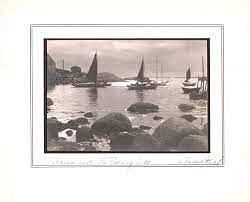This Old Thing: ‘Montreal cottage’ clock was made in Hamilton
Q. I bought this parts clock online for $30, even though it was pictured without hands or a pendulum. When I got it home, I found them in the grungy bottom of the case. The face seems to be cardboard which has the only marking of a tiny Maple Leaf with a ‘C’ in it just below the centre. The case stands 23.5 cm high (9.25 inches). I’m wondering if this will be a worthwhile effort to fix.
Cindy, Newmarket, Ont.
A. You have a very scarce clock and finding other examples manufactured by this company is difficult. This prompted me to consult expert Allan Symons — Curator of The Canadian Clock Museum located in Deep River, Ont., who provided the following information. This small timepiece has a spring-driven, 30-hour, time-only pendulum brass movement. It is the “Montreal cottage” model, 100 per cent made by the Canada Clock Company in Hamilton, Ont., between 1880 and 1884. The acid-etched design on the glass tablet is a common characteristic of many of the company’s wide range. Research indicates that both the movements and cases were made in Hamilton during that narrow period, even though case styles are similar to those made by Connecticut-based American competitors at that time. Although 30-hour clocks are less desirable than eight-day models for collectors, replacing this one would still cost $250 because of the generally good condition for its circa 140-year age.
Q. I have 28 postcards that were bought in Italy during the Second World War by my father while he was stationed there with his regiment — the Hastings & Prince Edward Regiment — better known as the ‘Hasty-Ps.’ The scenes are mainly from Rome, unused and have printed subject titles and dates of the 1940s. While I am curious if they are marketable, they are cherished souvenirs and will be passed on to the next generation. Thanks for your help.
Jocelyne, Gatineau, Que.
A. The marble carving of Moses done by Michelangelo resides in Rome at the church of San Pietro in Vincoli (Saint Peter in Chains). A hugely popular tourist destination such as this results in vast numbers of postcards being sold with this image. Many have survived and it is a fairly common card. Interestingly, the fact that it is unused can be attractive to some collectors while others prefer cards with written related stories and postage stamps. Other key factors affecting value are subjects (catastrophes are popular), photo cards are preferable to lithographed cards, condition and scene location. The internet has increased buyer attention and demand, while at the same time it can increase supply which lowers values. Your particular cards sell between $2.50 and $12. They are a wonderful family heirloom and treasure.
Q. I inherited three of these signed prints some time ago. This one is titled ‘Home with the Evening Tide.’ I know that Wallace MacAskill was a renowned photographer and you can see his skill in these pictures. They are about 9 by 13 cm (3.5 x 5 inches) and are in original wrapping — something like flimsy onion paper. What can you tell me about him and his work?
Bruce, Kanata, Ont.
A. Wallace R. MacAskill (1890-1956) studied photography in New York City during the first decade of the 1900s — a time when the Pictorialist Movement, led by Alfred Stieglitz, strongly influenced MacAskill. One of the techniques of Pictorialism was ‘soft focus’ which emphasized atmospheric characters such as misty mornings creating impressionistic moods. Once established in Halifax, this became his trademark. Many of his ‘captures’ were taken from 1911 to 1930, before his later pursuit and love of yachting in the 1930s when he won the Prince of Wales Cup several times. His shots of the famous schooner Bluenose are consistently valued significantly higher than most others — one of which was used for the Canadian postage stamp. Collectors will pay about $175 for your trio.














